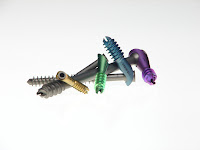
With major companies like Synthes leading the way with newer locking technology, along came the locking drill guide. This added precise accuracy when pre-drilling. Now the drill hole would maintain a centralized position aligning and locking the screw properly with the plate threads. Simple enough right? Not exactly. Problems can still arise
· Alteration of the locking construct following bending of the plate
o Likely the most common cause of problems
o Inherently alters the integrity of the plate threads disrupting the screw from seating properly within the plate.
· Not inserting the screw directly 90 degrees to the plate
o The screw head will not seat properly within the plate
o Can cause the metal to strip or peel off the head
o If enough force is applied, the head of the screw can actually break off
These downfalls can lead to failure with the locking construct and/or neutralize their locking effect, essentially making them no stronger than a non-locking plate. Fast forward to today. New advances in locking plate technology have evolved such that it gives the surgeon additional room for error when applying a locking plate.
Examples:

o Pre-loaded locking guides on the plates
- Eliminates the sometimes frustrating step of trying to get the drill guide to properly load into the plate
- Enables the surgeon the ability to bend the plate without disrupting the plate threads
o Variable angle capabilities.
o Now the screw does not need to be directed in precisely at 90 degrees
Some plates have eliminated the need for threads within the plate holes altogether:
· Extremity Medical IoFix Implant

o Although not a plate per say, the IoFix implant utilizes the locking plate idea. Based on the conical shape of the screw head, the screw essentially locks into the post as it is inserted.
o Utilizes a SurFix system

- There are no threads on the head of the screw
- Instead, a separate threaded washer, applied on top of the screw head, after the screw is inserted
Can traditional non-locking plates get the job done? Probably in most cases, yes. Do locking plates offer multiple advantages over standard plating options? Most definitely. Ultimately, the choice to use these new plating options rests in the hands of the surgeon. Regardless, advances in plating technology have and will continue to evolve, making it not only easier for the surgeon but also superior for the patient.











 Recently added to the
Recently added to the  With that said, every now and then there are changes within the industry, that we feel are important enough to bring attention to.
With that said, every now and then there are changes within the industry, that we feel are important enough to bring attention to. 


 We will continue to bring you more information and product highlights from the OIC as they are brought to market.
We will continue to bring you more information and product highlights from the OIC as they are brought to market.














